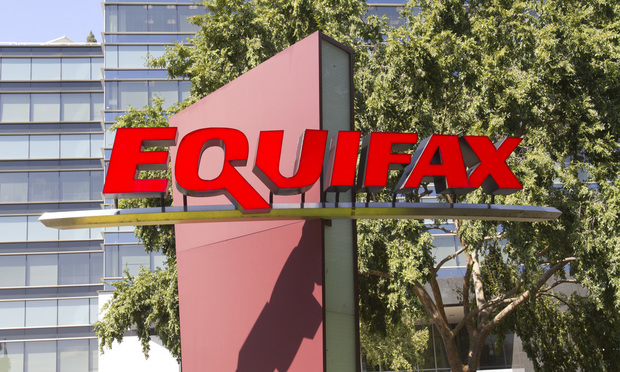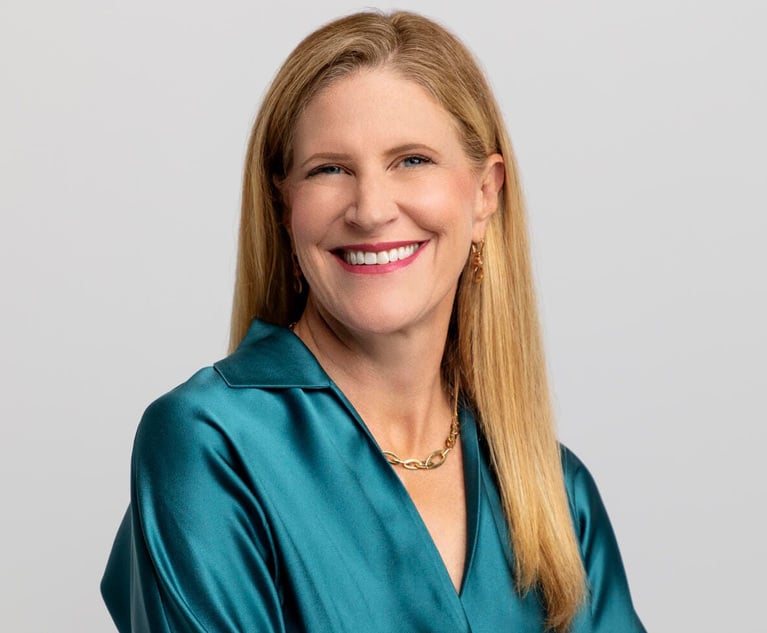Massive Equifax Data Breach Was Preventable: Congressional Report
Data privacy and cybersecurity attorneys interviewed Tuesday generally agreed that Equifax could have done more to prevent the 2017 data breach, but at least one prominent data privacy and data security lawyer said that the report was unfair because the government has done little to help protect U.S. companies and organizations from bad actors.
December 11, 2018 at 06:47 PM
6 minute read
 Equifax Atlanta HQ. Photo: John Disney/ALM
Equifax Atlanta HQ. Photo: John Disney/ALM
The U.S. House of Representatives Committee on Oversight and Government Reform released a report Monday that concluded the 2017 Equifax Inc. data breach that exposed the personal information of about 148 million consumers was entirely preventable.
Data privacy and cybersecurity attorneys interviewed Tuesday generally agreed with that assessment, however, at least one prominent data privacy and security lawyer said that she believed the report was unfair to the company, because the government has done little to help protect U.S. companies and organizations from bad actors.
“The Congressional report states that the breach was entirely preventable, but that seems to dismiss the fact that companies are under attack every day from foreign adversaries. It would be really good to see Congress talk about what Congress can do to help protect companies as opposed to just re-victimizing the victims,” said New York-based Morrison & Foerster partner and privacy co-chair Miriam Wugmeister, who is not representing Equifax. Wugmeister has spent years advising U.S. and multinational companies on data privacy and security and data breach response.
The congressional committee report disclosed that “after updating the security certificate, Equifax employees identified suspicious traffic from an IP address originating in China” and that “Equifax noticed additional suspicious traffic from a second IP address owned by a German ISP, but leased to a Chinese provider.”
According to the report, In March 2017, a software vulnerability was publicly disclosed that required a patch on Atlanta-based Equifax operating systems. In May 2017, hackers began a cyberattack on Equifax that lasted for 76 days. The intruders were able to access 48 databases during the attack. On July 31, former Chief Information Officer David Webb told former CEO Richard Smith about the incident and about how they suspected the vulnerability was exploited by the hackers during the data breach. On August 2, Equifax engaged the cybersecurity firm Mandiant to investigate, and Equifax notified outside counsel and the Federal Bureau of Investigation. By late August 2017, Mandiant confirmed that attackers had accessed a large amount of personally identifiable information, and Equifax started to prepare to make a public notice about the breach and constructed a website for consumers to find out if they were affected and if so, to access credit monitoring. Equifax actually notified the public about the breach Sept. 7, nearly four months later, according to the report.
The sheer size of the breach and delayed notification led to public and media outcry, and calls for government hearings and action by state attorneys general and other authorities.
The congressional report stated that Equifax should have addressed “at least two points of failure to mitigate, or even prevent, this data breach.” It said there was a lack of accountability and that no clear lines of authority in Equifax's IT management structure existed. It further stated that Equifax's “aggressive growth strategy and accumulation of data resulted in a complex IT environment.” The complexity of Equifax's IT system made IT security difficult. Further, Equifax did not know what kind of software was being used in its legacy environments. The lack of knowledge about its software was what led to a vulnerability being exploited by hackers, according to the report.
In a statement emailed to this reporter, an Equifax spokesperson said the company was disappointed they did not have an adequate amount of time to review and respond to the report before it was published.
“During the few hours we were given to conduct a preliminary review before they released it yesterday, we identified significant inaccuracies and disagree with many of the factual findings,” the statement said. Those inaccuracies, according to the Equifax spokesperson, include the idea that Equifax did not disclose any cybersecurity risks in its SEC filings prior to the 2017 data breach. The spokesperson said the company's 10-K reports addressed cybersecurity risk factors. The report further references a settlement with state attorneys general when the settlement has not occurred, according to the spokesperson.
Edward McAndrew, a partner at Ballard Spahr in Philadelphia, said the report serves as a reminder for companies that interpersonal relationships play a large part in protecting data and networks.
“The problematic IT structure is really important because it does explain why or provides the context as to how Equifax really failed at something as basic as patching,” McAndrew said. “You see this siloing within their IT structure from the security side of the house and the information technology side of the house.”
McAndrew explained that information technology and security are not the same thing, but at Equifax information technology and security were not in the same room and did not report to the same people.
Mark McCreary, the chief privacy officer and a partner at Fox Rothschild in Philadelphia, said he was pleased the report did not hold back in criticizing Equifax's network security.
“In speaking with the IT professionals in my world, all of them agreed that it is almost a certainty that there must have been numerous conversations regarding the flaws in existing technology and failures to keep technology and security solutions up-to-date. I understand that their consumer-facing system was nearly 50 years old and the breach point was a well-known issue with Apache Struts that has a fix widely available,” said in an email.
McCreary said that, in his view, the biggest takeaway from the report is that business must patch their systems.
“I felt the biggest takeaway from the report for a business is almost cliché but often undervalued. Businesses must patch their systems. Often it is that simple. The great things for executives is that they do not need to do much more than direct, empower and fund their information technology departments to be able to do those patches,” McCreary said in the email.
Read more:
Federal Data Privacy Legislation Is Likely Next Year, Tech Lawyers Say
Equifax Agrees to New Data Breach Safeguards in Consent Order With State Regulators
New York Takes the Lead on Cybersecurity Regulation
NYS DFS Issues Sweeping New FAQs Affecting Scope of Its Cybersecurity Regulations
This content has been archived. It is available through our partners, LexisNexis® and Bloomberg Law.
To view this content, please continue to their sites.
Not a Lexis Subscriber?
Subscribe Now
Not a Bloomberg Law Subscriber?
Subscribe Now
NOT FOR REPRINT
© 2025 ALM Global, LLC, All Rights Reserved. Request academic re-use from www.copyright.com. All other uses, submit a request to [email protected]. For more information visit Asset & Logo Licensing.
You Might Like
View All
Former Capital One Deputy GC Takes Legal Reins of AIG Spinoff

Khan Defends FTC Tenure, Does Not Address Post-Inauguration Plans

Apple Disputes 'Efforts to Manufacture' Imaging Sensor Claims Against iPhone 15 Technology
Trending Stories
- 1Stevens & Lee Names New Delaware Shareholder
- 2U.S. Supreme Court Denies Trump Effort to Halt Sentencing
- 3From CLO to President: Kevin Boon Takes the Helm at Mysten Labs
- 4How Law Schools Fared on California's July 2024 Bar Exam
- 5'Discordant Dots': Why Phila. Zantac Judge Rejected Bid for His Recusal
Who Got The Work
Michael G. Bongiorno, Andrew Scott Dulberg and Elizabeth E. Driscoll from Wilmer Cutler Pickering Hale and Dorr have stepped in to represent Symbotic Inc., an A.I.-enabled technology platform that focuses on increasing supply chain efficiency, and other defendants in a pending shareholder derivative lawsuit. The case, filed Oct. 2 in Massachusetts District Court by the Brown Law Firm on behalf of Stephen Austen, accuses certain officers and directors of misleading investors in regard to Symbotic's potential for margin growth by failing to disclose that the company was not equipped to timely deploy its systems or manage expenses through project delays. The case, assigned to U.S. District Judge Nathaniel M. Gorton, is 1:24-cv-12522, Austen v. Cohen et al.
Who Got The Work
Edmund Polubinski and Marie Killmond of Davis Polk & Wardwell have entered appearances for data platform software development company MongoDB and other defendants in a pending shareholder derivative lawsuit. The action, filed Oct. 7 in New York Southern District Court by the Brown Law Firm, accuses the company's directors and/or officers of falsely expressing confidence in the company’s restructuring of its sales incentive plan and downplaying the severity of decreases in its upfront commitments. The case is 1:24-cv-07594, Roy v. Ittycheria et al.
Who Got The Work
Amy O. Bruchs and Kurt F. Ellison of Michael Best & Friedrich have entered appearances for Epic Systems Corp. in a pending employment discrimination lawsuit. The suit was filed Sept. 7 in Wisconsin Western District Court by Levine Eisberner LLC and Siri & Glimstad on behalf of a project manager who claims that he was wrongfully terminated after applying for a religious exemption to the defendant's COVID-19 vaccine mandate. The case, assigned to U.S. Magistrate Judge Anita Marie Boor, is 3:24-cv-00630, Secker, Nathan v. Epic Systems Corporation.
Who Got The Work
David X. Sullivan, Thomas J. Finn and Gregory A. Hall from McCarter & English have entered appearances for Sunrun Installation Services in a pending civil rights lawsuit. The complaint was filed Sept. 4 in Connecticut District Court by attorney Robert M. Berke on behalf of former employee George Edward Steins, who was arrested and charged with employing an unregistered home improvement salesperson. The complaint alleges that had Sunrun informed the Connecticut Department of Consumer Protection that the plaintiff's employment had ended in 2017 and that he no longer held Sunrun's home improvement contractor license, he would not have been hit with charges, which were dismissed in May 2024. The case, assigned to U.S. District Judge Jeffrey A. Meyer, is 3:24-cv-01423, Steins v. Sunrun, Inc. et al.
Who Got The Work
Greenberg Traurig shareholder Joshua L. Raskin has entered an appearance for boohoo.com UK Ltd. in a pending patent infringement lawsuit. The suit, filed Sept. 3 in Texas Eastern District Court by Rozier Hardt McDonough on behalf of Alto Dynamics, asserts five patents related to an online shopping platform. The case, assigned to U.S. District Judge Rodney Gilstrap, is 2:24-cv-00719, Alto Dynamics, LLC v. boohoo.com UK Limited.
Featured Firms
Law Offices of Gary Martin Hays & Associates, P.C.
(470) 294-1674
Law Offices of Mark E. Salomone
(857) 444-6468
Smith & Hassler
(713) 739-1250







